
Burned to ash: An Indonesian Red Cross official examines the damage from the plumes of hot ash and lava from Mount Merapi at Bronggang village, Cangkringan, Sleman regency, in Yogyakarta on Friday. The 750 degree Celsius hot gas burned down several villages and killed more than 70 people from Thursday midnight. JP/Slamet Susanto
Hot clouds of ash and lava from smoldering Mount Merapi claimed more victims Friday, torching at least two villages in Yogyakarta and killing dozens of more lives.
The death toll from the disaster climbed to 122 on Friday, forcing authorities to expand the danger zone to a 20-kilometer radius from the mountain.
Ash showers spread to most cities in Central Java and Yogyakarta, where Indonesia’s most active volcano is located, and even reached as far as Bandung and Bogor, West Java.
Energy and Mineral Resources Ministry Geological Agency head R. Sukhyar said Merapi’s eruption could be heard up to 20 kilometers away while volcanic ash had reached as far as Bandung.
“Merapi’s eruption on Friday was the biggest in the country since Mount Galunggung’s eruption in 1982.
It is the biggest for Merapi in the past century,” he said Friday. Sukhyar said it was hard to calculate when the volcano would cease activity. “Do not ask us when it will stop. We really don’t know. Magma continues spilling.”
Before Friday’s eruption, the volcano had killed 44 people, mostly in its first eruption on Oct. 26, which destroyed two villages, Kaliadem and Kinahrejo, both in Cangkringan district, Sleman regency, Yogyakarta.
Two more villages, Bronggang Suruh in Argomulyo and Slodokan in Wukirsari, were completely devastated by the volcano’s hot clouds of ash and lava Friday.
“We did not predict hot clouds would reach Argomulyo, which is not located inside the 20-kilometer danger zone,” said Argomulyo resident Nur Syamsu Hadi on Friday. “The blast was very frightening. It was so loud and strong.”
He said most residents did not flee to safety, believing they were in the safe zone. The subdistrict is just 14.2 kilometers from the crater.
“People should have known to leave areas within 20 kilometers of Merapi. We have informed them,” Sleman administration spokeswoman Endah Sri Widiastuti said.
Volcanology and Geological Disaster Mitigation Center (PVMBG) head Surono said the magma supply from Friday’s eruption had risen from a depth of 7 kilometers beneath the crater. Previously, the eruptions’ magma came from a 2-kilometer depth. “That’s why the tremor could be heard up to a radius of 20 kilometers from the volcano,” he said.
Friday’s eruption also disrupted traffic and forced Yogyakarta’s Adi Sutjipto Airport authority to temporarily close the airport Friday. It is scheduled to resume activity Saturday morning.
National flag carrier Garuda Indonesia spokesman Pujobroto said in a statement that all passengers can reschedule their flights or refund their tickets by calling the Garuda Call Center at 08041807807.
Retno, a passenger of a Yogyakarta-Jakarta flight, said she was told her flight was canceled. “I have to wait until tomorrow for my flight.”
Soekarno-Hatta International Airport authority also canceled all flights leaving for Yogyakarta for safety reasons. The cancelation affected a total of 41 flights bound for Yogyakarta, causing thousands of passengers to be stranded for hours at Terminal 1.
Panti Nugroho Hospital on Jl. Kaliurang also decided to close operation Friday and evacuated its patients to Panti Rapih Hospital in downtown Yogyakarta.
“We made the decision as the site is no longer safe,” said the hospital’s director, Tendean Arif Wibowo.
Rescuers worked hard to evacuate survivors and the dead, struggling to cope with thick, hot volcanic dust and smoke from burning material.
“Evacuating victims is difficult since the condition is still dangerous. We prioritize survivors so they can immediately be sent to hospital,” said Purwo Gogon of Yogyakarta’s search and rescue team.
Victims, with clothes, blankets and even mattresses fused to their skin from 750 degree Celsius heat, were evacuated on stretchers following the explosion, The Associated Press reported.
Soldiers joined rescue operations in hardest-hit Bronggang village, pulling at least 78 bodies from homes and streets blanketed by ash up to 30-centimeters deep.
“The heat surrounded us and there was white smoke everywhere,” Niti Raharjo, 47, who was thrown from his motorbike along with his 19-year-old son while trying to flee, told the AP.
“I saw people running, screaming in the dark, people were so scared they fell unconscious,” he said from his hospital bed. “There was an explosion that sounded like bombs during a war ... and it got worse with ash and debris raining down.”
Police officer Col. Tjiptono told AP that most bodies were found in front of houses and on streets, adding it appeared many villagers died from searing gas while trying to escape.
In Semarang, head of Central Java Disaster Mitigation Body Djarot Nugroho said the eruption was beyond the calculations of PVMBG, the authority responsible for the regional administrations’ disaster mitigation plan.
These miscalculations, he said, were responsible for the failure to implement disaster mitigation plans, mainly in regards to refugees.
“Makeshift tents are unavailable since the area where they were deployed is now included in the danger zone,” he said Friday.
Source : http://www.thejakartapost.com


























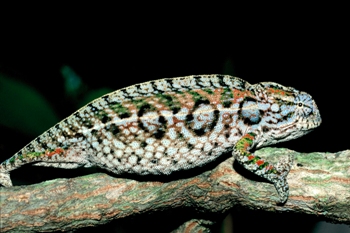

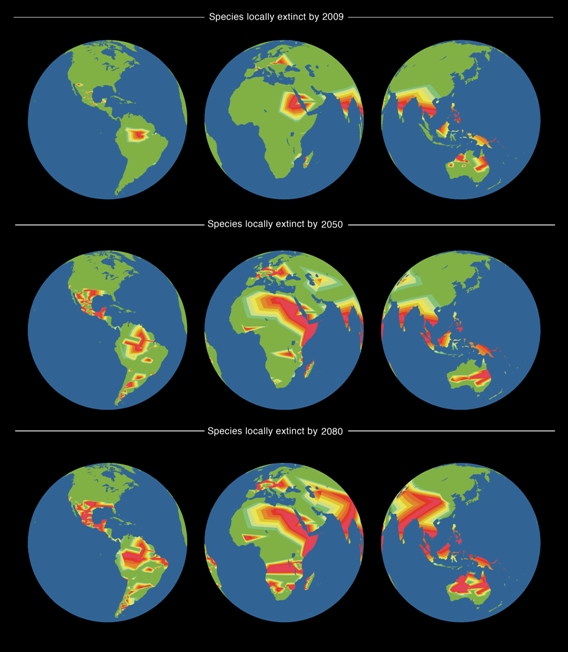
 (03/04/2009) With help from data collected thirty years ago, scientists have discovered that tropical lizards may be particularly sensitive to a warming world. Researchers found that lizards in the tropics are more sensitive to higher temperatures than their relatives in cooler, yet more variable climates. "The least heat-tolerant lizards in the world are found at the lowest latitudes, in the tropical forests. I find that amazing," said Raymond Huey, lead author of a paper appearing in the March 4 Proceedings of the Royal Society B.
(03/04/2009) With help from data collected thirty years ago, scientists have discovered that tropical lizards may be particularly sensitive to a warming world. Researchers found that lizards in the tropics are more sensitive to higher temperatures than their relatives in cooler, yet more variable climates. "The least heat-tolerant lizards in the world are found at the lowest latitudes, in the tropical forests. I find that amazing," said Raymond Huey, lead author of a paper appearing in the March 4 Proceedings of the Royal Society B. (11/04/2009) Currently there are an estimated nearly 9,000 reptiles in the world, while the International Union for Conservation of Nature (IUCN) Red List has assessed all of the world's described mammals, birds, and amphibians, reptiles have yet to be fully assessed, leaving herpetologists with an unclear picture of how reptiles are faring in the world. Currently, 1,677 reptiles have been assessed (less than 20 percent of the total number of reptile species known) with 293 added this year.
(11/04/2009) Currently there are an estimated nearly 9,000 reptiles in the world, while the International Union for Conservation of Nature (IUCN) Red List has assessed all of the world's described mammals, birds, and amphibians, reptiles have yet to be fully assessed, leaving herpetologists with an unclear picture of how reptiles are faring in the world. Currently, 1,677 reptiles have been assessed (less than 20 percent of the total number of reptile species known) with 293 added this year. (03/07/2007) High above the forest floor on the remote Colombian island of Gorgona lives a lizard with brilliant blue skin, rivaling the color of the sky. Anolis gorgonae, or the blue anole, is a species so elusive and rare, that scientists have been unable to give even an estimate of its population. Due to the lizard&spod;s isolated habitat and reclusive habits, researchers know little about the blue anole, but are captivated by its stunning coloration.
(03/07/2007) High above the forest floor on the remote Colombian island of Gorgona lives a lizard with brilliant blue skin, rivaling the color of the sky. Anolis gorgonae, or the blue anole, is a species so elusive and rare, that scientists have been unable to give even an estimate of its population. Due to the lizard&spod;s isolated habitat and reclusive habits, researchers know little about the blue anole, but are captivated by its stunning coloration.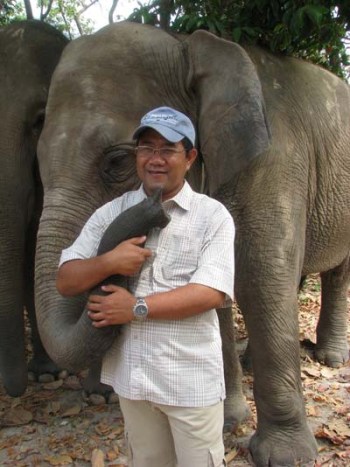

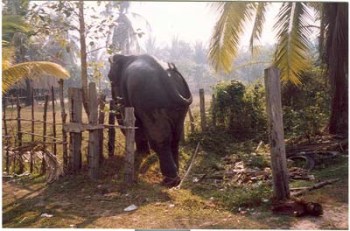
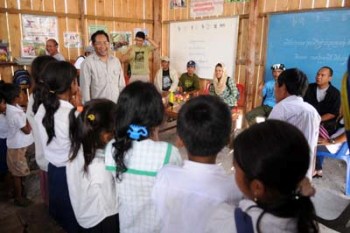

 (05/17/2010) Although urban Britain is not the native habitat of the Asian elephant, the well-loved pachyderm has invaded London for the summer. Raising awareness and funds for the threatened Asian elephant, 250 fiberglass statues by different artists are being displayed all over London. At the end of the summer the elephants will be auctioned off. All the proceeds from the art parade will go to Elephant Family, a conservation organization whose mission is to save the Asian Elephant from extinction.
(05/17/2010) Although urban Britain is not the native habitat of the Asian elephant, the well-loved pachyderm has invaded London for the summer. Raising awareness and funds for the threatened Asian elephant, 250 fiberglass statues by different artists are being displayed all over London. At the end of the summer the elephants will be auctioned off. All the proceeds from the art parade will go to Elephant Family, a conservation organization whose mission is to save the Asian Elephant from extinction. (06/10/2009) Three different species of frogs have been discovered living in the dung of the Asian elephant in southeastern Sri Lanka. The discovery—the first time anyone has recorded frogs living in elephant droppings—has widespread conservation implications both for frogs and Asian elephants, which are in decline. "I found the frogs fortuitously during a field study about seed dispersal by elephants," Ahimsa Campos-Arceiz, a research fellow from the University of Tokyo, told Monagaby.com.
(06/10/2009) Three different species of frogs have been discovered living in the dung of the Asian elephant in southeastern Sri Lanka. The discovery—the first time anyone has recorded frogs living in elephant droppings—has widespread conservation implications both for frogs and Asian elephants, which are in decline. "I found the frogs fortuitously during a field study about seed dispersal by elephants," Ahimsa Campos-Arceiz, a research fellow from the University of Tokyo, told Monagaby.com. (01/15/2009) A population of 631 Asian elephants has been documented in Malaysia's Taman Negara National Park, reports the Wildlife Conservation Society (WCS). The population may be the largest in Southeast Asia. Scientists from WCS and Malaysia's Department of Wildlife and National Parks (DWNP) counted elephant dung piles to estimate the protected area's population size. There were no previous scientific population surveys for elephants in the park.
(01/15/2009) A population of 631 Asian elephants has been documented in Malaysia's Taman Negara National Park, reports the Wildlife Conservation Society (WCS). The population may be the largest in Southeast Asia. Scientists from WCS and Malaysia's Department of Wildlife and National Parks (DWNP) counted elephant dung piles to estimate the protected area's population size. There were no previous scientific population surveys for elephants in the park. 













